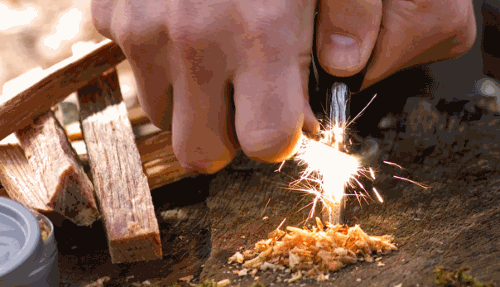Wilderness survival is a near endless skillset, it can be hard to know where to focus your attention and what skills you should hone before moving on to less essential skills that fall more under the broad term of “bushcraft” rather than survival. The main difference between bushcraft and survival is that bushcraft is more intentional, whereas survival is more responsive. Here is a list of the 5 most important survival skills that you should “master” before moving on to other skills.
- Fire Starting
While building a shelter should be higher on your priority list in most situations, fire is crucial for more than heat regulation and therefore tops the list. Without fire you will not be able to boil water to avoid potentially deadly waterborne diseases, cook foods that are only edible if they have been cooked, create a signal fire for rescue, and of course stay warm to avoid hypothermia.
- Shelter Building
Your skills don’t need to be that of the Robinson family, but you do need to have a basic knowledge of what shelters you can manufacture with the material in your area during different seasons, and what conditions will dictate the shelters you need to build.
- Water Procurement
Even in mild weather and without much physical activity, you will dehydrate to the point of death in only a few days without drinkable water. In addition to knowing where to look for water you should be familiar with methods such as dew collection, transpiration bags, and solar stills for times when streams and lakes are not available.
- Signaling
With the above three items covered you will be able to hold out for weeks, but a lot can happen in that time and you don’t want to in the wilderness longer than you have to when you’re not there for a camping trip. Knowing how to build a signal fire, use a mirror to signal, or construct other improvised signals is essential to get you the help you need.
- Basic Navigation
Getting rescued is great, but it might not be an option that is available to you. Knowing basic navigation, for night time, day, and inclement weather is essential for you to be able to get yourself out. Familiarize yourself with just some of the basics like a sun compass, finding the North star, and natural indicators like tree formation and river flow to help you get a bearing while getting yourself to safety.
You don’t need to become Bear Grylls, or better yet Ray Mears overnight. If you start with these 5 skills and build from there to things like wild foraging, first aide, and trap building, you will be set.
If you liked this, you might also enjoy…



Reality TV has vividly demonstrated what a lifetime of experience has taught.
More failures of teams to survive primitive conditions have been caused by the failure to secure (in the following order):
Shelter
Fire
Water
after those options open up.
Whether one is in Hot, Cold, or Rainy weather, the lack of shelter seems to be the most immediate threat to human endurance, productivity, and ultimately survival. To conserve one’s strength and energy it is critical to obtain shelter as quickly as possible.
Nearly coincidental with, and very nearly as critical as, is the ability to create fire. Fire is essential for nearly the same reasons as shelter. Neither replenishes nourishment and energy; but, both conserve what you start with.
Before the first night falls one would be well-advised to spend the remaining daylight gathering material for shelter and fire. The actual construction of either can be done as night begins to fall; however, oftentimes, moving about and finding what one is looking for after dark is more difficult as well as more dangerous. Get the materials gathered before dark; start a fire as night falls – for both light and safety; and, proceed to spend as much of your first night as necessary creating shelter and warmth.
The next day (assuming one located their campsite near a water source) will be soon enough to develop a potable water supply. This will likely be a much less labor intensive activity than construction activity and can be combined with reconnaissance activity to identify available food sources.
At that point survival will mostly become a repetitive cycle of maintaining and improving those items. Other tasks will be required as needed and/or desired.
This is all great information. Is there a book than be purchased with this info?
We currently have a premium newsletter with more in-depth survival content. I will send an email when the order form is ready. You can also check out my new book “Grocer Store Ninja” here: http://survivalstronghold.com/sale/
wEre is my newes photo